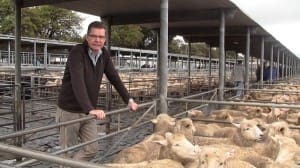A new industry biosecurity and animal health initiatives hopes to reduce the risk of an emergency animal disease through producer education.
The Livestock Biosecurity Network (LBN) is an independent industry group designed to promote greater awareness of bio-security risk and to improve on-farm preparedness for exotic and endemic disease outbreaks.
LBN is peak councils’ brainchild
The network is the brainchild of Australia’s three peak farming industry organisations: Cattle Council of Australia, Sheepmeat Council of Australia and WoolProducers Australia, which have pooled $5 million to fund the LBN after three years of intensive planning.
Through the LBN, livestock producers will be made aware of the importance of animal health, welfare and bio-security and be alerted to the latest science and legislation relating to their on-farm practices.
The LBN’s regional officer for Victoria, veterinarian Dr Patrick Kluver, said the key to protecting sheep flocks from unwanted diseases, pests and weeds is the preparation of an effective bio-security plan.
Foot and mouth disease outbreak could cost $50 million
A good plan was inexpensive to prepare and implement, and would have immediate pay-offs in preventing disease incursions and limiting their spread if they were inadvertently introduced, he said
“Sheep diseases reduce productivity, income, access to markets and impact animal health and welfare,” Dr Kluver said.
“A nation-wide outbreak of foot and mouth disease, for example, could strip more than $50 billion from Australia’s livestock industry over 10 years,” he said.
“The biggest cost is losing markets, so good on-farm bio-security goes a long way towards protecting our markets. At the same time, bio-security is important for protecting farm assets. A bio-security plan costs very little, but the return is immediate, ongoing and cumulative.”
Farm level bio-security involved a range of day-to-day practices to buffer livestock from infectious diseases and encompasses the veterinary, husbandry and management actions for ensuring healthy and well-cared for animals.
“By far, the greatest risk of disease is bringing sheep onto the farm, either by buying sheep or stray sheep entering from a neighbouring property through poor fencing,” Dr Kluver said.
“The other areas of importance are vehicles coming on to your place – shooters, livestock agents or sales people – inadvertently bringing disease with them on their vehicles.
“That can be easily controlled through signage saying you’re restricting people and how they move on and off the farm.”
An effective bio-security plan has three simple stages
An effective bio-security plan involved three, simple stages: pre-farmgate, farmgate and post-farmgate.
The pre-farmgate involves the Sheep Health Statement for information on sheep diseases – lice, footrot, ovine brucellosis and ovine Johnes disease (OJD) – and any recent treatments.
“It also provides information on the vendor’s bio-security risk, including if the vendor has a bio-security plan and how often they purchase sheep.
“Make sure that any consignment you buy has a Sheep Health Statement,” he said.
Dr Kluver said producers should always inspect sheep personally either at the yards, or on-farm, before purchasing, looking for footrot, lice and ensuring stock are in good condition.
Stage two involves a footbath and quarantine drench at the farmgate and the post-farm-gate measures include placing the sheep in a quarantine paddock before joining the rest of the flock.
Dr Kluver said these procedures should be followed for all stock entering a property, including ewes, wethers and stud rams, as they are all at risk of bringing in disease and this equally applies for sheep which have strayed onto a neighbouring property.
“The procedures performed at the farm gate and after for on-farm quarantine should be practised by all farmers no matter where they have purchased their sheep from.
“Early detection and management of any diseases, pests or weeds will catch any problems before they take hold.”
More information on how to prepare a farm bio-security plan is available twww.farmbiosecurity.com.au or at the Livestock Biosecurity Network website, www.lbn.org.au.


HAVE YOUR SAY